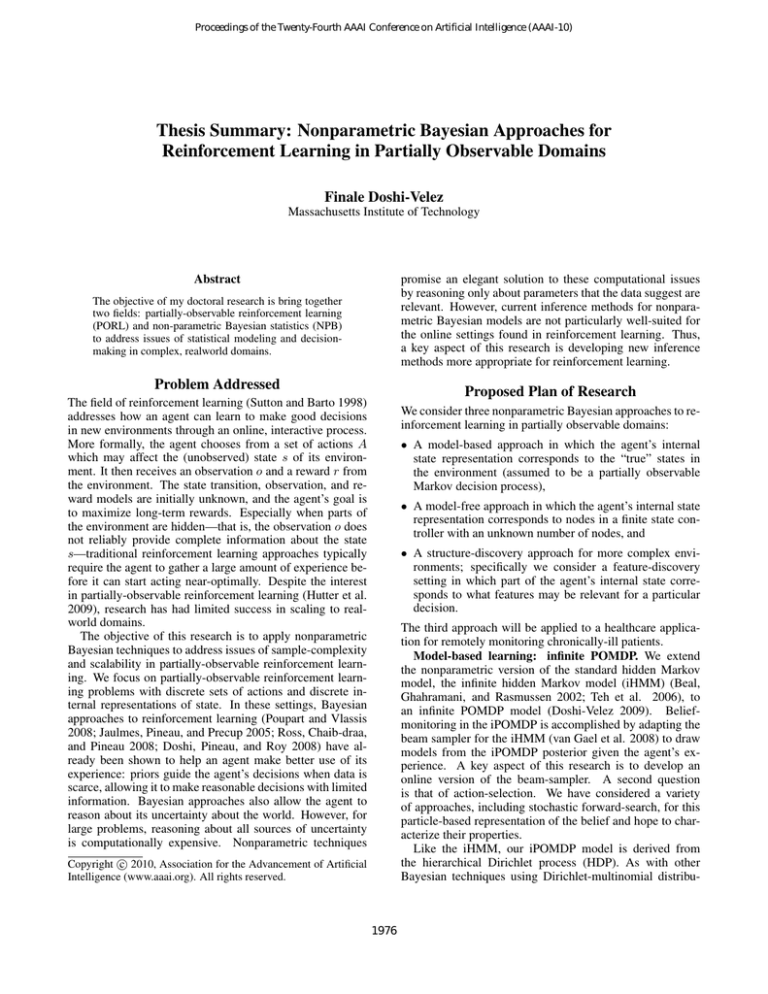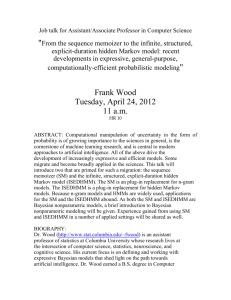
Proceedings of the Twenty-Fourth AAAI Conference on Artificial Intelligence (AAAI-10)
Thesis Summary: Nonparametric Bayesian Approaches for
Reinforcement Learning in Partially Observable Domains
Finale Doshi-Velez
Massachusetts Institute of Technology
Abstract
promise an elegant solution to these computational issues
by reasoning only about parameters that the data suggest are
relevant. However, current inference methods for nonparametric Bayesian models are not particularly well-suited for
the online settings found in reinforcement learning. Thus,
a key aspect of this research is developing new inference
methods more appropriate for reinforcement learning.
The objective of my doctoral research is bring together
two fields: partially-observable reinforcement learning
(PORL) and non-parametric Bayesian statistics (NPB)
to address issues of statistical modeling and decisionmaking in complex, realworld domains.
Problem Addressed
Proposed Plan of Research
The field of reinforcement learning (Sutton and Barto 1998)
addresses how an agent can learn to make good decisions
in new environments through an online, interactive process.
More formally, the agent chooses from a set of actions A
which may affect the (unobserved) state s of its environment. It then receives an observation o and a reward r from
the environment. The state transition, observation, and reward models are initially unknown, and the agent’s goal is
to maximize long-term rewards. Especially when parts of
the environment are hidden—that is, the observation o does
not reliably provide complete information about the state
s—traditional reinforcement learning approaches typically
require the agent to gather a large amount of experience before it can start acting near-optimally. Despite the interest
in partially-observable reinforcement learning (Hutter et al.
2009), research has had limited success in scaling to realworld domains.
The objective of this research is to apply nonparametric
Bayesian techniques to address issues of sample-complexity
and scalability in partially-observable reinforcement learning. We focus on partially-observable reinforcement learning problems with discrete sets of actions and discrete internal representations of state. In these settings, Bayesian
approaches to reinforcement learning (Poupart and Vlassis
2008; Jaulmes, Pineau, and Precup 2005; Ross, Chaib-draa,
and Pineau 2008; Doshi, Pineau, and Roy 2008) have already been shown to help an agent make better use of its
experience: priors guide the agent’s decisions when data is
scarce, allowing it to make reasonable decisions with limited
information. Bayesian approaches also allow the agent to
reason about its uncertainty about the world. However, for
large problems, reasoning about all sources of uncertainty
is computationally expensive. Nonparametric techniques
We consider three nonparametric Bayesian approaches to reinforcement learning in partially observable domains:
• A model-based approach in which the agent’s internal
state representation corresponds to the “true” states in
the environment (assumed to be a partially observable
Markov decision process),
• A model-free approach in which the agent’s internal state
representation corresponds to nodes in a finite state controller with an unknown number of nodes, and
• A structure-discovery approach for more complex environments; specifically we consider a feature-discovery
setting in which part of the agent’s internal state corresponds to what features may be relevant for a particular
decision.
The third approach will be applied to a healthcare application for remotely monitoring chronically-ill patients.
Model-based learning: infinite POMDP. We extend
the nonparametric version of the standard hidden Markov
model, the infinite hidden Markov model (iHMM) (Beal,
Ghahramani, and Rasmussen 2002; Teh et al. 2006), to
an infinite POMDP model (Doshi-Velez 2009). Beliefmonitoring in the iPOMDP is accomplished by adapting the
beam sampler for the iHMM (van Gael et al. 2008) to draw
models from the iPOMDP posterior given the agent’s experience. A key aspect of this research is to develop an
online version of the beam-sampler. A second question
is that of action-selection. We have considered a variety
of approaches, including stochastic forward-search, for this
particle-based representation of the belief and hope to characterize their properties.
Like the iHMM, our iPOMDP model is derived from
the hierarchical Dirichlet process (HDP). As with other
Bayesian techniques using Dirichlet-multinomial distribu-
c 2010, Association for the Advancement of Artificial
Copyright Intelligence (www.aaai.org). All rights reserved.
1976
next goal is to be able to quickly classify a new patient soon
after enrollment, so that the approach can be applied to a real
healthcare setting.
tions, the agent infers its transition, observation, and reward models based on counts of how often it believes it has
experienced those events. Thus, given a set of somewhatsimilar possible models, deep look-aheads—many counts—
are needed for the agent to differentiate these models and
realize the value of reducing model uncertainty.
We hypothesize that biasing the agent toward proposing
more radically different models and more confident learning can alleviate this problem. We are currently trying
two approaches: adjusting the concentration parameters on
the iHMM and developing a hierarchical Pitman-Yor (HPYHMM) model to induce even stronger model differentiation
and sparsity.
Model-free learning: infinite state controllers. We focus on learning policies that can be represented with stochastic state controllers (e.g. (Hansen 1998)). When the underlying state dynamics are complex, such policy-based approaches can provide more compact solutions; they are also
more amenable to certain types of expert input, such as
alarm-thresholds in the healthcare domain.
We are currently testing an approach that uses a Gaussian
process to place a distribution over the value of a policy.
Symmetries in the policy-encoding mean that many polices
produce similar behavior, so we wish to compare policies
based on the distributions of histories they produce (rather
than directly comparing their parameters). We use importance weighting techniques from (Shelton 2001) to compare
how likely a history produced by one policy is to be produced by another policy. By placing an optimistic mean
function as the prior on the Gaussian process, we bias the
agent to try new policies.
The above approach is principled but computationally expensive. In future work, we hope to leverage similarities
between the iPOMDP and the iSC: both build discrete internal state representations with stochastic transitions between
nodes that are conditioned on certain inputs (actions for the
iPOMDP, observations for the iSC) and produce stochastic
outputs (observations for the iPOMDP, actions for the iSC).
The key difference is that the iPOMDP overlays a belief over
its internal state, while the iSC “fully observes” its internal
state. A second thrust of our iSC work to apply inference for
the iPOMDP to learn policies instead of models.
Online structure-discovery. The first two approaches
don’t explicitly consider structure that may present in the environment. We focus on a very specific structure-discovery
problem relevant to our healthcare application, where we
wish to predict upcoming incidents (hospitalizations, ER
visits, etc.) based on a patient’s current history of vital signs,
basic statistics, and previous incidents. Here, both the patient’s true condition as well as what features are relevant to
predicting his or her true condition are initially unknown.
Combinations of the basic inputs can produce very highdimensional feature vectors.
Our goal is to simultaneously discover which features are
relevant for different subpopulations of patients and segment
patients into subpopulations based on their what features are
relevant for them. As a first step, we propose to use nested
combinations of Dirichlet and Indian Buffet processes to
model the population segmentations in a batch setting. Our
Progress
My master’s theses separately studied Bayesian approaches
to PORL (Doshi, Pineau, and Roy 2008) and scalable inference in the Indian Buffet Process, a discrete nonparametric Bayesian model. Last year, I began work on the infinite POMDP model (Doshi-Velez 2009), and we have already observed that the iPOMDP approach results in faster
learning rates than using EM (tests using different priors
are currently underway). I am also in the process of testing an initial implementation of the model-free infinite state
controller algorithm on some toy problems. Finally, I obtained the healthcare-related data in February 2010 and am
in the process of exploratory data analysis and testing initial feature discovery algorithms. My plan for the rest of the
spring is to continue work on the model-free iSC approach
and structure-discovery work with the healthcare data. I will
also be writing my thesis proposal and forming my thesis
committee.
References
Beal, M. J.; Ghahramani, Z.; and Rasmussen, C. E. 2002.
The infinite hidden Markov model. In Machine Learning,
29–245. MIT Press.
Doshi, F.; Pineau, J.; and Roy, N. 2008. Reinforcement
learning with limited reinforcement: Using Bayes risk for
active learning in POMDPs. In ICML, volume 25.
Doshi-Velez, F. 2009. The infinite partially observable
markov decision process. In NIPS.
Hansen, E. A. 1998. An improved policy iteration algorithm
for partially observable MDPs. In NIPS, volume 10.
Hutter, M.; Uther, W.; Poupart, P.; and Ng, K. S.
2009. Partially observable reinforcement learning nips minisymposium.
Jaulmes, R.; Pineau, J.; and Precup, D. 2005. Learning
in non-stationary partially observable Markov decision processes. ECML Workshop.
Poupart, P., and Vlassis, N. 2008. Model-based Bayesian
reinforcement learning in partially observable domains. In
ISAIM.
Ross, S.; Chaib-draa, B.; and Pineau, J. 2008. Bayesadaptive POMDPs. In NIPS.
Shelton, C. R. 2001. Policy improvement for POMDPs using normalized importance sampling. AI Memo 2001-002,
MIT AI Lab.
Sutton, R. S., and Barto, A. G. 1998. Reinforcement learning: An introduction.
Teh, Y. W.; Jordan, M. I.; Beal, M. J.; and Blei, D. M. 2006.
Hierarchical Dirichlet processes. Journal of the American
Statistical Association 101(476):1566–1581.
van Gael, J.; Saatci, Y.; Teh, Y. W.; and Ghahramani, Z.
2008. Beam sampling for the infinite hidden Markov model.
In ICML, volume 25.
1977








